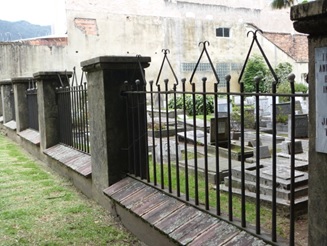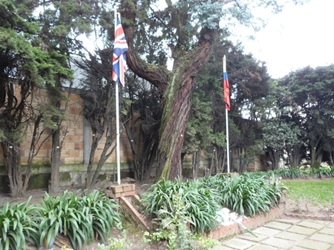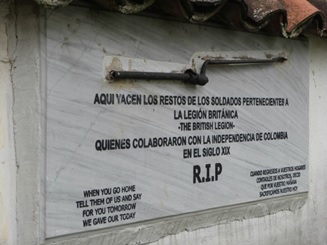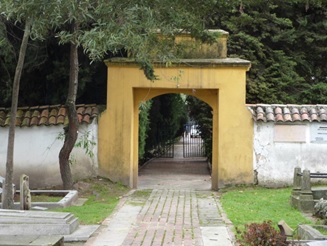
Luke Jonathan Edmunds*
Home land on foreign soil generally comes in two forms: a country’s embassy or a cemetery. I was well aware of the British embassy in Bogota, some twenty blocks north of our Angelico building, but not of the other, the British cemetery located in San Diego. Walled away on 26th street, nestled at the side of the Cementerio Central lies British soil, a plot of land given to Colombia’s ally for their support in the fight for independence. It provided a resting place for some of the fallen five thousand British soldiers who set sail from London in 1817 to fight against the Spanish.
With keen interest I set off to visit this curious piece of home. Having passed the Cementerio Central countless times, it bugged me how I could have missed the neighbouring cemetery found next door to one of Bogota’s historic sites. From the many fallen in Western Europe to those that lost their lives building the infamous Death Railway along the Burmese border, I have always made an effort to visit my fallen countrymen, but in over two years as a Bogota inhabitant, I simply had no idea. Knocking on the big, black gates crowned with barbed wire that mark the entrance, my ignorance to the fact was hardly surprising; nothing indicates to the visitor that they stand at cemetery gates. And, as a prompt phone call informed me, one will not get much further than gates themselves without direct permission from the embassy. Foiled for the day as I watched the Ciclovía pass by, I confess to having had little expectation for the embassy’s collaboration.
Undeterred, the next day I was pleasantly surprised to find the embassy in collaborative mood. I met with a Colombian, Nelson, who informed me that the restriction was due to unfortunate incidents of theft over the years; apparently for some dishonest folk 19th century bayonets might fetch a fair price, or sit well upon the mantelpiece. Nelson said he would do what he could and let me know, and to my great appreciation he came through, permission granted and even sending me some documents on the cemetery’s history. Dando vueltas can be a tedious process, but just sometimes we come into contact with good people; thanks to Nelson.

Another day, and under a drizzling Bogota sky, welcomed through the domineering gate by the cemetery’s Colombian administrator Edgar, I finally stepped onto British soil. Eerily silent as cemeteries tend to be, immediately inside stand the Colombian and British flags as the outside city humdrum echoes through and the skyscrapers up from the avenue Caracas peer down over the cemetery’s walls. As one walks through the gardens however, two observations become immediately apparent: few gravestones are for soldiers, and there is an array of nationalities interred, not just British. On the latter, Edgar explains to me that over the years numerous non-British foreigners have requested and been granted burial in the cemetery. On the former that it is not known how many of the British Legionnaires who fell fighting alongside Bolivar were actually laid to rest in the cemetery. Only plaques mark their memory.
Deeper into the grounds, fences formed of bayonets house the cemetery’s older sector. Here lies the grave of the first recorded burial, William Duffin, first registrar of the cemetery, dated 1830. According to Edgar, his grave sits alongside the ground where it is believed that many of the nameless soldiers’ remains are interred. This sector is home to the three gravestones that are actually marked with the names of British soldiers: Colonels MacKintosh and Bendle, and Captain Smith.

Whether Britain soldiers really contributed a great military prowess towards Colombia’s struggle for independence is debatable: many were seen as being significantly less than effective, but the few that fought and fell did enough in the eyes of the Colombian people for them to designate a plot of land in their honour that, although hidden away, still survives and to some extent tells part of the story on Colombia’s path to independence; newly born independent nations look to the international community for recognition and it is widely accepted that Britain’s recognition, despite coming after the US, acted as a guarantee in the international community of the newly born nation of Colombia.
A foreigner living overseas often inevitably feels isolated, distant from the culture despite efforts to integrate. This is no different to my own experience as a British citizen living in Colombia, yet with a little exploration, plodding along the labyrinth of Bogota’s limitless expanse, I was able to discover evidence of a link between our two nations that has remained for more than two hundred years, a piece of shared history that helps to lift that sense of isolation.

Luke Jonathan Edmunds*
Docente Universidad Santo Tomás
Las opiniones expresadas en esta sección son de exclusiva responsabilidad del autor y no reflejan, necesariamente, los puntos de vista de la Universidad Santo Tomás.
ARTE-FACTO. Revista de Estudiantes de Humanidades
ISSN 2619-421X (en línea) enero 2018 No. 5

